Return to Managing Chemical Waste.
- Containers: Sealing and Labeling
- Mixing Hazardous Wastes
- Waste Container Storage Areas, Proper Storage, Improper Storage and Limits
- Quick Facts
- Waste Satellite Accumulation Area Reference Sign
Hazardous Waste Containers
Hazardous waste must be stored in containers (including lids) made of materials that are compatible with the waste. Hazardous waste containers must be in good condition and free of leaks or any residue on the outside of the container. Unacceptable containers include household detergent and food service containers. The best container for your hazardous waste is the original chemical container.
Sealing Hazardous Waste Containers
Hazardous waste containers must be sealed to prevent leakage or spillage. Containers should be sealed with a screw-type lid or other appropriate device. Plastic wrap, aluminum foil, and other make-shift lids are unacceptable. A container holding hazardous waste must ALWAYS be closed during storage, except when it is necessary to add or remove waste.
Labeling Hazardous Waste Containers
Hazardous waste containers must be labeled with hazardous chemical waste tags provided by OCRS as soon as the container is used to collect hazardous waste, regardless of whether the container is full. These tags require the laboratory to provide specific information including name, telephone number, building, room number, and exact contents of the container. The date should be filled out when the container is full. It is important to include as much information as is known about the contents of the hazardous waste container, including percentages and water content, to facilitate disposal. If a container is being used to collect hazardous waste intermittently, the tag should be filled out immediately upon use of the container and must be edited as more waste is added. A separate tag must accompany each individual hazardous waste container. Old labels that do not accurately describe the contents of the waste container (i.e., the original label for a toluene bottle now being used to store waste xylene) must be defaced.
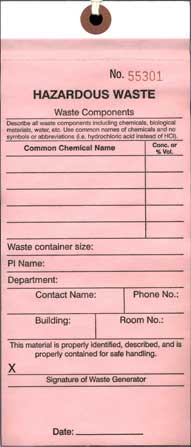
Pink Chemical Waste Tag
Mixing Hazardous Wastes
Hazardous wastes should be kept separate whenever possible. Mixing a hazardous waste with a non-hazardous waste can increase the volume of hazardous waste for disposal. Mixing hazardous wastes with other hazardous wastes can increase disposal costs due to differences in disposal options for certain hazardous wastes. For instance, halogenated solvents such as methylene chloride and chloroform are more costly to dispose of than non-halogenated solvents such as hexane and xylene; therefore, halogenated solvent wastes should be kept separate from non-halogenated solvent wastes.
Hazardous Waste Container Storage Area
You should designate an isolated portion of your laboratory as a hazardous waste storage area. Laboratories with multiple rooms may designate one hazardous waste accumulation area for all rooms as long as hazardous waste will not have to be transported in or across a hallway or through any area that is not controlled by the lab. Hazardous wastes must be stored with secondary containment so that spills cannot reach sink, hood, or floor drains. Incompatible hazardous wastes must be segregated to prevent reaction. Segregation methods include storing in separate cabinets, storing in separate hoods, or storing in separate secondary containment containers such as 5-gallon buckets or tubs. Please refer to your laboratory's Chemical Hygiene Plan or the OCRS Fact Sheet "Laboratory Activation Guide" for guidelines on segregating chemicals by hazard class. Post a copy of the "Hazardous Chemical Waste Accumulation Area Reference Sign" in your waste storage area to provide a quick reference for these procedures.
Properly Stored Hazardous Waste
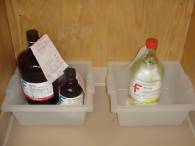 In this photo, hazardous waste is labeled with pink chemical waste tags, segregated by chemical compatibility, stored in secondary containment, and kept in an isolated area.
In this photo, hazardous waste is labeled with pink chemical waste tags, segregated by chemical compatibility, stored in secondary containment, and kept in an isolated area.
Improperly Stored Hazardous Waste
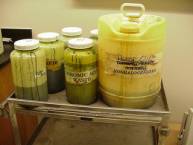
In this photo, there are no OCRS labels, no secondary containment, no segregation, and containers are covered with waste residue.
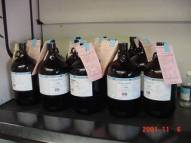
In this example, there is no secondary containment from hood drain and storage is in a high traffic area.
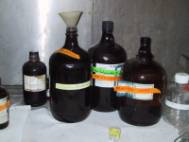
In this example, there are no OCRS labels, no secondary containment, and one container has not been properly sealed (open funnel).
Hazardous Waste Storage Limits
Your laboratory must NOT store more than 55 gallons of hazardous waste or one quart of acute hazardous waste at one time. You must have your hazardous waste and acute hazardous waste collected at such a frequency to prevent from exceeding these limits. If these limits are ever exceeded, you must immediately submit a collection request form to OCRS, as described in the OCRS Environmental Fact Sheet, "Disposing of Hazardous Waste." Please see the OCRS Environmental Fact Sheet, "Identifying Hazardous Wastes in Your Laboratory" for the definition of acute hazardous waste.
You must also consider your storage capacity when establishing your storage area. Hazardous waste must be stored in a manner to minimize the risk of a spill, stored with secondary containment, and segregated by compatibility. You must not store hazardous waste in quantities that prevent proper storage practices. Based on your laboratory's rate of generation of hazardous waste, your storage capacity, and keeping in mind the quantity limits described above, you must determine the amount of hazardous waste you will accumulate in your storage area prior to having it collected by OCRS. Laboratories should try to minimize storage of hazardous waste.
Quick Facts About Hazardous Waste Storage
- Store hazardous waste in sealed, compatible containers.
- Hazardous waste containers must be kept closed at all times except to add waste.
- Label hazardous waste containers with OCRS chemical waste tags as soon as waste accumulation begins.
- Store hazardous wastes with secondary containment.
- Segregate incompatible hazardous wastes.
- Never accumulate more than 55 gallons of hazardous waste or one quart of acute hazardous waste.
- Ensure that lab personnel are trained on proper waste handling procedures.